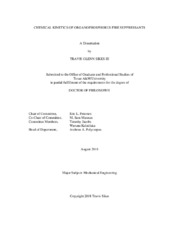| dc.description.abstract | Organophosphorus compounds (OPCs) have significant fire suppression capabilities but are not well understood. Chemical kinetics mechanisms can provide invaluable information about how OPCs suppress flames; however, the currently available OPC mechanisms are deficient and could use further refinement. In this dissertation, two types of experimental data were taken which can be used as benchmarks to improve mechanisms: laminar flame speeds and ignition delay times. In the laminar flame speed experiments, dimethyl methylphosphonate (DMMP), diethyl methylphosphonate (DEMP) diisopropyl methylphosphonate (DIMP), and trimethyl phosphate (TEP) were added to hydrogen/air and methane/air mixtures to assess their suppression capabilities at 0.1% and 0.3% (DMMP only) of the total mixture volume. The experiments were performed in an optically tracked, spherically expanding flame setup at 1 atm and 120 °C. Results show a 30% decrease in laminar flame speed for all OPCs at 0.1% on the methane/air parent mixture. For the hydrogen/air mixtures, the OPCs differentiate themselves by having an increasing suppression effect corresponding with higher carbon moiety, i.e., DIMP (20% overall reduction), > TEP (15%) > DEMP (13%) > DMMP (9%). The OPCs also have an increasing effect with increasing equivalence ratio on hydrogen/air. Ignition delay time experiments were performed in a glass shock tube at ICARE – CNRS.
The simple OPCs studied were dimethyl phosphite (DMP), trimethyl phosphate (TMP), and diethyl phosphite (DEP). The OPCs were added as 10% of the fuel in hydrogen/ethylene mixtures diluted with 98% argon. The results show that the three OPCs behave similarly in both hydrogen and ethylene mixtures by decreasing the ignition delay time ~30% at high temperatures and then decreasing in effect until the neat and OPC data are indistinguishable. Additionally, quantum chemistry calculations were performed to improve an existing OPC submechanism using ROCBS-QB3 level of theory for thermochemistry and G3X-K for the transition state calculations. The thermochemistry data are an improvement on previous OPC mechanisms, but overall the model does not predict the ignition delay times. Further OPC submechanism improvement is needed to resolve simple OPC reactions so that larger OPC submechanisms will be able to properly predict OPC behavior in applications such as fire suppression. | en |


